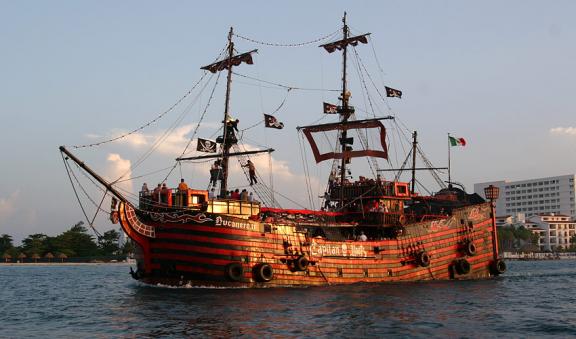
Note: This article was originally printed with the title, "Captain Hook Meets Adam Smith.Two 30" diameter, 18" pitch standard ship's propellers (screws)
CAPTAIN HOOK PIRATE FREE
Until Somalia establishes a rule of law and a lawful free market for its citizens, lawless black market piracy will remain profitable. Markets operating in a lawless society are more like black markets than free markets, and because the Somali government has lost control of its society, Somali pirates are essentially free to take the law into their own hands. It is in everyone’s economic interest to negotiate the transactions as quickly and peacefully as possible.


This economic analysis also explains why Somali pirates typically receive ransom payoffs instead of violent resistance from shipping crews and their owners. But as 18th-century English pirate Captain Sam Bellamy explained, “I scorn to do any one a Mischief, when it is not for my Advantage.” Leeson concludes, “By signaling pirates’ identity to potential targets, the Jolly Roger prevented bloody battle that would needlessly injure or kill not only pirates, but also innocent merchant seamen.” Of course, to maintain that reputation, pirates occasionally had to engage in violence, reports of which they provided to newspaper editors, who duly published them in gory and exaggerated detail. Leeson says it was a signal to merchant ships that they were about to be boarded by a marauding horde of heartless heathens the nonviolent surrender of all booty was therefore perceived as preferable to fighting back. Consider the Jolly Roger flag that displayed the skull and crossbones.
CAPTAIN HOOK PIRATE CODE
to prevent Disputes and Ranglings afterwards.” Thus, the pirate code “emerged from piratical interactions and information sharing, not from a pirate king who centrally designed and imposed a common code on all current and future sea bandits.”įrom where, then, did the myth of piratical lawlessness and anarchy arise? From the pirates themselves, who helped to perpetrate the myth to minimize losses and maximize profits. When ever any enter on board of these Ships voluntarily, they are obliged to sign all their Articles of Agreement. In the words of one observer: “All swore to ’em, upon a Hatchet for want of a Bible. Just as civil courts required witnesses to swear on the Bible, pirate crews had to consent to the captain’s codes before sailing. (The last could lead to the “free rider” problem in which the even division of loot among uneven efforts leads to resentment, retaliation and economic chaos.) Enforcement was key. Those documents commonly outlined rules about drinking, smoking, gambling, sex (no boys or women allowed onboard), use of fire and candles, fighting and disorderly conduct, desertion and shirking one’s duties during battle. Just as historians have demonstrated that the “Wild West” of 19th-century America was a relatively ordered society in which ranchers, farmers and miners concocted their own rules and institutions for conflict resolution way before the long arm of federal law reached them, Leeson shows how pirate communities democratically elected their captains and constructed constitutions. Pirate societies, in fact, provide evidence for Smith’s theory that economies are the result of bottom-up spontaneous self-organized order that naturally arises from social interactions, as opposed to top-down bureaucratic design. abstain from robbing and murdering one another.” If there is any society among robbers and murderers, they must at least. “To cooperate for mutual gain-indeed, to advance their criminal organization at all-pirates needed to prevent their outlaw society from degenerating into bedlam.” There is honor among thieves, as Adam Smith noted in The Theory of Moral Sentiments: “Society cannot subsist among those who are at all times ready to hurt and injure one another.

Thus, Leeson says, pirate life was “orderly and honest” and had to be to meet buccaneers’ economic goal of turning a profit. Piratical mythology can’t be true, in fact, because no community of people could possibly be successful at anything for any length of time if their society were utterly anarchistic. Leeson in his myth-busting book, The Invisible Hook (Princeton University Press, 2009), which shows how the unseen hand of economic exchange produces social cohesion even among pirates. Not so, dissents George Mason University economist Peter T. Anarchy was the rule, and the rule of law was nonexistent. Pirates of the Caribbean: Dead Man’s Chestįrom countless films and books we all know that, historically, pirates were criminally insane, traitorous thieves, torturers and terrorists. We should turn and fight.”Ĭaptain Jack Sparrow: “Why fight when you can negotiate?” Will Turner: “If we can outrun her, we can take her.


 0 kommentar(er)
0 kommentar(er)
